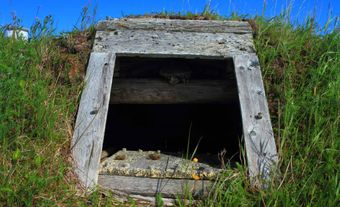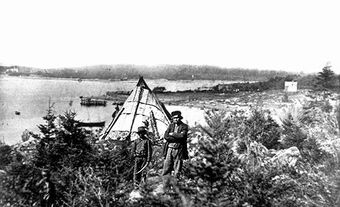Japanese Gardens in Canada
Japanese gardens, deeply rooted in complex spiritual, literary, and philosophical traditions specific to Japan, have been a feature of Canadian estates and public places for more than a century. They have proven highly adaptable regarding materials and response to Canada's climate, materials and sites. Beautiful to experience on any level, whether sensory or symbolic, Japanese gardens in Canada provide a place of refuge amid often busy urban settings.Of 2 main types of Japanese gardens - dry-landscape or Zen gardens, and stroll gardens - Canadians have commissioned predominantly the latter. Dry-landscape gardens feature raked gravel and rocks symbolizing water and islands. They provide a stimulus for meditation and reflection and are intended to be viewed, not walked through. Stroll gardens invite movement through them to appreciate different perspectives. Stroll gardens typically include flowing water (but usually not fountains), carefully selected rocks, bridges, lanterns, plants and trees, and fish (often multi-coloured carp - known as "living flowers"). Each element has a symbolic significance, reinforcing values associated with harmony, renewal, calm, continuity, and veneration of nature.
The earliest and still among the best Japanese gardens in Canada are found in Victoria, BC. While on a sojourn in Canada between 1907 and 1912, Isaburo Kishida, a noted professional gardener and park designer from Yokohama, designed 4 gardens in or near Victoria. Two are still extant. The earliest (and now lost) was designed for a site in Esquimalt, BC, at BC Electric Gorge Park; the garden opened on 11 Jul 1907 and survived until 1942. The popularity of the Gorge tea house and garden design prompted Victorians to commission Kishida to design 3 other Japanese gardens - a rock garden in the Butchart Gardens, in 1908; the Japanese Garden at Hatley Park National Historic Site, 1909 and 1913 (the latter date being the garden as expanded by Boston landscape architects Brett & Hall); and a private garden realized during these years for Sir F.S. Barnard, for a now-lost estate known as Clovelly.
Working with client and garden designer Jennie Butchart, Kishida designed a Japanese garden on one of the earliest portions of the now-renowned Butchart Gardens in Brentwood Bay, 23 km (14 miles) north of Victoria. At this site, Kishida helped introduce to BC indigenous Japanese plants and trees from Yokohama (including umbrella pines, or sciadopitys verticillata), some of which still survive today. As historian Lyle Dick has observed, the original garden design featured hybrid qualities, both North American and Japanese, as well as Japanese elements combined in a way that would have been unusual in Japan: "Bearing elements of the Japanese gardening tradition, such as the aural landscape of a stream, imported stone lanterns, wooden bridges, and Japanese maples, it also had a distinctive North American character. For its entrance, Butchart selected a red lacquered torii gate [literally a bird perch], a common element at Shinto shrines but atypical of Japanese gardens. She also incorporated such plant material as indigenous dogwoods into the concept."
At Hatley Castle, a large estate that eventually included an Italian garden as well as a rose garden, the Japanese garden enjoys a beautiful and picturesque site that makes it among the most beautiful of any garden in the country. Graced with bridges and ample water elements, the garden includes many exotic trees and plantings, some indigenous to Japan, others characteristic of the mature forest canopy of British Columbia, including, among many others, copper beech (fagus sylvatica), red cedar (thuja plicata), Japanese maple (acer palmatum), Mt. Fuji cherry (prunus serrulata), many colours and varieties of decidious azalea (rhododendron), and more Japanese umbrella pines. Now more than 100 years old, this venerable garden, formerly owned by the Department of National Defence and currently by Royal Roads University, is remarkable in any season.
Several Japanese gardens commemorate closer ties between Canada and Japan. This is notably true of Vancouver's Nitobe Garden, as well as gardens in Lethbridge and Edmonton. Kannosuke Mori designed Nitobe Memorial Garden, opened in 1960, which honours Inazo Nitobe (1862-1933), a complex individual who strove "to become a bridge across the Pacific." The Nitobe Garden provides the visitor with as close to what one might experience in a genuine Japanese garden as is possible in Canada. Carefully conceived, patiently constructed and meticulously maintained for generations, the Nitobe Garden is surely the best known and likely the most beautiful of any Japanese garden in Canada. Lethbridge, Alberta's Nikka Yuko Japanese Garden (the name means Japan-Canada Friendship) opened in 1967 and recognizes the contributions made by Japanese-Canadians in southern Alberta. Designer Tadashi Kubo consulted with local organizers to ensure that the garden adheres to Japanese traditions as well as incorporating local plants and materials. In 1971 the garden received a Vincent Massey Award for Excellence in the Urban Environment. In Edmonton, the Kurimoto Japanese Garden, created 1989-90, provides opportunities for cultural exchanges between Canadians and Japanese.
Other gardens commemorate the sense of loss due to the INTERNMENT of Japanese-Canadians during World War II. This is the case for gardens on Mayne Island, BC (1999-2002) and for the Nikkei Internment Centre and Garden in New Denver, BC, a tiny, picturesque village where many Canadians of Japanese extraction were interned during World War II. Roy Sumi, a Vancouver-based landscape gardener who had supervised the Nitobe Garden for many years, designed the small yet pristine garden at the Internment Centre (completed prior to 1997).
Although Montréal has colder winters than Victoria, and thus is more limited than BC in terms of the plant species that will flourish, the Japanese garden at the Montreal Botanical Garden, designed during the 1980s by noted Japanese designer Ken Nakajima, offers a convincing simulacrum of Japan, including multi-layered symbolic connotations. For example, lamps in the garden evoke the elaborate Japanese tea ceremony, symbolizing light clearing away clouds of ignorance. Local materials add a uniquely Canadian flavor, as seen in the choice of rare peridotite, an emerald-green stone sourced from Thetford Mines (Québec). The Japanese garden occupies a 2.5-hectare component of the much larger botanical garden that FRÈRE MARIE-VICTORIN founded in 1931.
In 1995, the CANADIAN MUSEUM OF CIVILIZATION in Hull, Québec, completed the first stage of a dry-landscape Zen garden on one of the lower roofs of the building. This roof garden was designed by Shunmyo Masuno, a Zen priest and master landscape architect, with the theme Wakei No Niwa, a reference to understanding and respect between the Japanese and Canadian people. Most of the materials used are from the region, with native plants and stone sourced from the nearby Gatineau Hills. In 1989, city staff in Mississauga designed the small Japanese garden at Kariya Park in Mississauga, Ontario (commissioned in honour of Mississauga's sister city Kariya in Japan); landscape architects in Japan then reviewed the master plan. Between 1986 and 1994 the Takata Japanese Garden Society attempted to recreate a garden on the site of the historic Japanese garden in Gorge Park, a project that eventually evolved into a partnership between Saanich, BC's Horticultural Centre of the Pacific, founded 1978, and Takata Garden Partnership. Construction of the Takata Garden began in 1995 and a dry-landscape Zen garden was completed in 2003, paying tribute to the first Japanese gardens designed in Canada in 1907.

 Share on Facebook
Share on Facebook Share on X
Share on X Share by Email
Share by Email Share on Google Classroom
Share on Google Classroom


